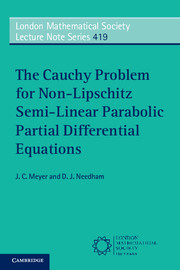Book contents
- Frontmatter
- Contents
- List of Notations
- 1 Introduction
- 2 The Bounded Reaction-Diffusion Cauchy Problem
- 3 Maximum Principles
- 4 Diffusion Theory
- 5 Convolution Functions, Function Spaces, Integral Equations and Equivalence Lemmas
- 6 The Bounded Reaction-Diffusion Cauchy Problem with f ∊ L
- 7 The Bounded Reaction-Diffusion Cauchy Problem with f ∊ Lu
- 8 The Bounded Reaction-Diffusion Cauchy Problem with f ∊ Hα
- 9 Application to Specific Problems
- 10 Extensions and Concluding Remarks
- References
- Index
1 - Introduction
Published online by Cambridge University Press: 05 August 2015
- Frontmatter
- Contents
- List of Notations
- 1 Introduction
- 2 The Bounded Reaction-Diffusion Cauchy Problem
- 3 Maximum Principles
- 4 Diffusion Theory
- 5 Convolution Functions, Function Spaces, Integral Equations and Equivalence Lemmas
- 6 The Bounded Reaction-Diffusion Cauchy Problem with f ∊ L
- 7 The Bounded Reaction-Diffusion Cauchy Problem with f ∊ Lu
- 8 The Bounded Reaction-Diffusion Cauchy Problem with f ∊ Hα
- 9 Application to Specific Problems
- 10 Extensions and Concluding Remarks
- References
- Index
Summary
The study of solutions to systems of semi-linear parabolic partial differential equations has attracted considerable attention over the past fifty years.In the case when the nonlinearity satisfies a local Lipschitz condition, the fundamental theory is well developed (see, for example, the texts of Friedman [21], Fife [20], Rothe [65], Smoller [70], Samarskii et al. [67], Volpert et al. [72], Leach and Needham [36], and references therein). The situation when the nonlinearity does not necessarily satisfy a local Lipschitz condition is less well studied, but contributions have been made in the case of specific non-Lipschitz nonlinearities which have aided in particular applications (see, for example, Aguirre and Escobedo [5]; Needham et al. [36], [54], [29], [33], [40], [41], [42], [43] and references therein), and for the corresponding steady state elliptic problems (see, for example, Stakgold [71], Bandle et al [9], [10], [11], [12], [13], Abdullaev [2], [3], [4], [1] and references therein). The aim of this monograph is to exhibit general results concerning semi-linear parabolic partial differential equations that do not necessarily satisfy a local Lipschitz condition. The approach is classical, in the sense that the results relate entirely to the well-posedness criteria for classical solutions, in the sense of Hadamard [39], and the main results are principally established within the framework of real analysis. The approach used to develop the existence theory in this monograph has similarities with the method of successive approximations for systems of first order ordinary differential equations, as detailed in [17] and [16]. Alternative approaches may be possible through the concepts of weak solutions and the framework of semigroup theory. These alternative approaches are amenable, and very effective, in the case of Lipschitz continuous nonlinearities, as exemplified in the monographs by Henry [26] and Pazy [62]. However, the extensions to non-Lipschitz nonlinearities have not been developed and our approach provides an effective development of the classical theory for Lipschitz continuous nonlinearities.
- Type
- Chapter
- Information
- The Cauchy Problem for Non-Lipschitz Semi-Linear Parabolic Partial Differential Equations , pp. 1 - 6Publisher: Cambridge University PressPrint publication year: 2015

